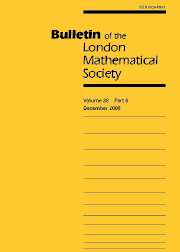No CrossRef data available.
Article contents
LOCALIZATION OF CLOSED (OR PERIODIC) SOLUTIONS OF A DIFFERENTIAL SYSTEM WITH CONCAVE NONLINEARITIES
Published online by Cambridge University Press: 10 March 2005
Abstract
Consider a scalar differential equation $\dot{x}\,{=}\,f(t,x), (t,x)\,{\in}\,I\,{\times}\,\R$, where $I$ is an open interval containing $[0,\,T]$. Assume that $f(t,x)$ is continuous with a continuous derivative $f^{\prime}_{x}(t,x)$, and weakly concave (or weakly convex) in $x$ for all $t \in I$, though strictly concave (or strictly convex) for some $t\,{\in}\,[0,\,T$]. It is well known that in this case there can be either no, one or two closed solutions; that is, solutions $\varphi(t)$ for which $\varphi(0)=\varphi$$(T)$ If there are two closed solutions, then the greater has a negative characteristic exponent and the smaller has a positive one. It is easily seen that this is equivalent to a statement on localization of closed solutions. It is shown how this statement can be generalized to systems of differential equations $\dot{\underline x} = \underline{f}(t,\underline{x}), (t,\underline{x})\in I \times \R^{n}$. The requirements are that the coordinate functions ${f}_{j}(t,\underline{x})$ be continuous with continuous derivatives with respect to $x_{1},x_{2},\ldots,x_{n}$, that the $f_j$ are weakly concave (or weakly convex) in $\underline{\it x}$, and that a certain condition pertaining to strict concavity (or strict convexity) is fulfilled.
Information
- Type
- Papers
- Information
- Copyright
- © The London Mathematical Society 2005

